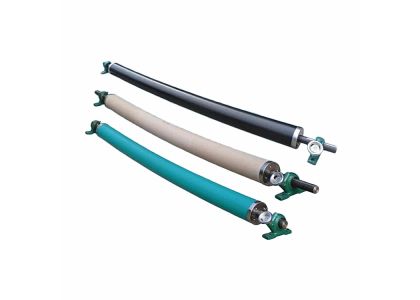Jctprint Machinery Co., Ltd

In the modern printing industry, the design and performance of equipment directly impact production efficiency and product quality. Bowed rollers, as a specially designed type of roller, are essential tools for many businesses aiming to improve operational efficiency due to their unique operating principles and broad range of applications. This article delves into the working principles of bowed rollers, their types and applications, selection and customization, maintenance, and the latest market trends.
Bowed rollers have a curved design that significantly influences how materials are processed. Specifically, this curvature increases the contact area between the roller and the material, improving pressure distribution and ultimately enhancing the uniformity of ink or coating distribution during the printing or coating process.
Fluid Dynamics Analysis: Analyzing material flow on a bowed roller surface through fluid dynamics helps explain how contact angles and pressure distributions reduce fluctuations in coating thickness, achieving a more consistent coating. Studies show that increasing the radius of curvature by 10% improves the evenness of coating distribution by approximately 15%, which is particularly beneficial for packaging and labeling applications where high-precision coating is required.
Typical Parameters: The angle of curvature on bowed rollers typically ranges from 5 to 10 degrees. By adjusting the angle and pressure, materials can be linearly extended along the roller, preventing folds or wrinkles in thin film materials during coating.
Bowed rollers can generally be categorized into several types, including banana rollers and bowed spreader rollers, each tailored to specific applications.
Banana Roller: Shaped like a banana, these rollers are widely used in coating applications, particularly with viscous materials. They help reduce air bubbles, enhancing visual appeal and quality. For example, banana rollers can reduce bubble formation by approximately 30% in PVC coating applications, significantly improving the final product’s appearance.
Bowed Spreader Roller: Bowed spreader rollers are extensively applied in flexographic and offset printing. Tests show that bowed rollers with a 5 to 7-degree curvature can improve ink adhesion by 15-20% on plastic films, yielding vibrant printed results. For high-speed printing, increasing the curvature can effectively minimize ink skipping.
Expander Roll / Expander Roller: Typically used to describe air shafts or expansion rollers, expander rollers serve to adjust the tension and width of materials, ensuring proper alignment during the printing or coating process.
Bowed Roller / Bowed Spreader Roller: These bowed rollers are primarily used to achieve uniform material distribution and tension control, preventing uneven spreading and ensuring consistent quality.
Banana Roller: With a shape resembling a banana, this roller is commonly applied in specific coating or printing applications to improve contact and coating effectiveness, especially where precision spreading is critical.
Selecting the right bowed roller requires considering multiple factors, including roller size, curvature radius, and material.
Selection Criteria:
Customization Case Study: A food packaging company customized a PVC-specific bowed roller with a curvature radius of 150 millimeters. By optimizing the curvature, they solved issues of uneven coating and bubble formation, resulting in a 20% increase in yield and an annual material cost savings of about 150,000 yuan.
Proper maintenance of bowed rollers is essential to extend their service life. Good maintenance not only enhances equipment reliability but also lowers long-term costs.
Maintenance Techniques:
Data Analysis: A statistical analysis of bowed roller maintenance shows that proper care can extend the service life to over five years while maintaining a stable coating quality, effectively avoiding downtime and resource waste associated with equipment replacement.
With the printing industry’s shift toward sustainability and digital transformation, bowed roller technology continues to evolve. New material applications and the introduction of smart manufacturing are enhancing bowed roller performance.
Industry Trends: Growing demand for eco-friendly coatings and efficient equipment has driven bowed roller design to prioritize sustainability and efficiency. For instance, new carbon fiber composite materials are now being used in bowed roller production, reducing weight by 30% and lowering energy consumption by 15% compared to traditional materials. Furthermore, integrating smart sensor technology allows bowed rollers to perform real-time monitoring and send alerts when detecting wear or abnormal temperatures. Such innovations help companies increase efficiency and embrace intelligent manufacturing.